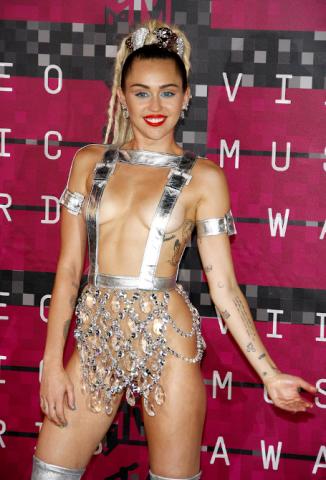Miley Cyrus’ Sexual Politics

After her controversial VMA performance, Miley Cyrus quickly took over the rest of 2013. At the awards ceremony, she stripped down for Robin Thicke’s “Blurred Lines” and grinded against the married singer—just like the music video for the single. Since then, her prevalent tongue has been everywhere, and tabloids will make a story out of every haircut, every gesture she makes.
This is not shocking. This is not new. Miley Cyrus’ move to a more sexualized being is a part of the cycle that her predecessors like Britney Spears and even Madonna were subject to (Madonna’s case is entirely different; however, many audiences reacted to her sexuality in a similar way).
Cyrus was actively blamed for her raunchy behavior: it was not questioned that there was a choreographer calling the shots, and no one was blaming the married-with-kids singer Thicke for complying with such behavior. And why would they? For the most part, people aren't actively criticizing the gender politics of One Direction--or even boy bands more generally. It's not because there is nothing to criticize, but rather, as a woman—and as a woman pop icon especially—it is her job to personify “other” women.
We see this in John Berger’s pivotal work Ways of Seeing. Berger reads gender roles in paintings throughout history. He writes, “If a woman throws a glass on the floor, this is an example of how she treats her own emotions of anger and so of how she would with it to be treated by others. If a man does the same, his action is only read as an expression of his anger.” In other words, a woman is always a symbol of herself. In our culture, we often feed labels onto women in the media: the business woman, the stay-at-home-mom, the virgin, the vamp.
This makes way for women in pop culture—like Miley Cyrus—being held to the standard of every other woman. The pressure for women in the media to be role models for young girls creates a false dichotomy: a Jezebel article states, “Critiquing famous (or any) women's behavior in terms of whether what they do is good for the girls or not is a sticky trap. It prevents them from being complicated, actual people working themselves out.”
Cyrus came from the world of Disney, growing up as Hannah Montana, and was supposedly contractually obligated to keep her hair long. Who is surprised that once she switched gears, the singer cut off all of her hair and moved away from the Hannah Montana image? The VMAs has historically been a breeding ground for “shocking” sexual stage work. Cyrus’s twerking was definitely sexual, but was it sexy? She came out of a bear and stuck her tongue out: the statement wasn’t sexy, but the gesture of sex in pop culture will, almost without fail, make audiences’ jaws drop, even though we have seen this many times before.

An article by Spencer Kornhaber in The Atlantic argues that the VMAs are largely a conservative entity. He writes, “Miley Cyrus’s much discussed ‘filthy’ performance of
‘We Can’t Stop’ and ‘Blurred Lines’ seems less like a let-loose dare than a carefully thought-through iteration on the brand-name that is ‘Miley Cyrus.’” He continues: “It’s the sequel where the kids’ franchise turns unexpectedly dark, or the sexier reboot of an old storyline.”
Beyoncé’s racy opening act at the Grammys last week even got outraged parents claiming the pop sensation went too far. Beyoncé is her own manager, a grown woman, and phenomenal singer. She has been happily married for years. She is not allowed to flaunt her sexuality too much. The “Drunk In Love” singer has been largely avoidant of this type of criticism, but she is not immune either. Pop audiences have a hard time accepting sexual women, but they will keep buying the product. The music industry continues to do what works.
Cyrus has claimed that she is one of the “biggest feminists in the world” in an interview with BBC Newsbeat. While there has been a lack of sex positive icons in our pop canon, the “Wrecking Ball” singer is very much a product of our cultural moment. Susan J. Douglas argues in her book Where the Girls Are: Growing Up Female with the Mass Media that consumerism has taken on feminist mantras to tout narcissism. The ever-present “Because I’m worth it” phrase is certainly a result of this approach.
Douglas looks at a series of ads titled “Reflections On…” but this largely applies to the way women understand themselves in the media and social life today. She writes, “The ads suggested that without inner confidence, and a core self that is assured and discriminating (made possible, one can infer, by feminism), these women would not be the charmers they are today. But without male approval and admiration, they would not have the acclaim on which narcissistic self-esteem rests.” Women are allowed to be narcissists only if the male gaze approves.
Madonna was criticized constantly for her sexuality and she played with the concepts Douglas is speaking of. John Fiske writes in his book, Understanding Popular Culture,“[Madonna] is excessive and obvious; she exceeds all the norms of the sexualized female body and exposes their obviousness along with her midriff. Her sexualization of her naval is a parody of patriarchy’s eroticization of female body fragments – she is a patriarchal text shot through with skepticism.” Many observers, though, did not appreciate these politics.
Britney Spears’ attempt to take control made her demonized by the tabloids, and she never really recovered. She shaved her head, came at paparazzi, and had a mental breakdown. Spears’ mom, Lynn Spears, wrote in her book that executives insisted “in order to compete with other sexy stars, they needed to sell Britney as a sort of ‘Lolita.’”
Sexuality isn’t the problem. A woman’s lack of control in the music industry (among others) and exploitation of her body is the problem. Sex is so much a part of our culture, and to deny its place in music (or entertainment, more broadly) is to deny its prescience.
Sex sells: this much we know. Audiences continue to holler about women stripping down as though the naked female body is still shocking. And if the viewers continue their shock each time we go through this cycle, the entertainment industry will continue to push us through it.
Author Bio:
Mary Kinney is a contributing writer at Highbrow Magazine.
Photo: Depositphotos.com






























































































































































































































































































































